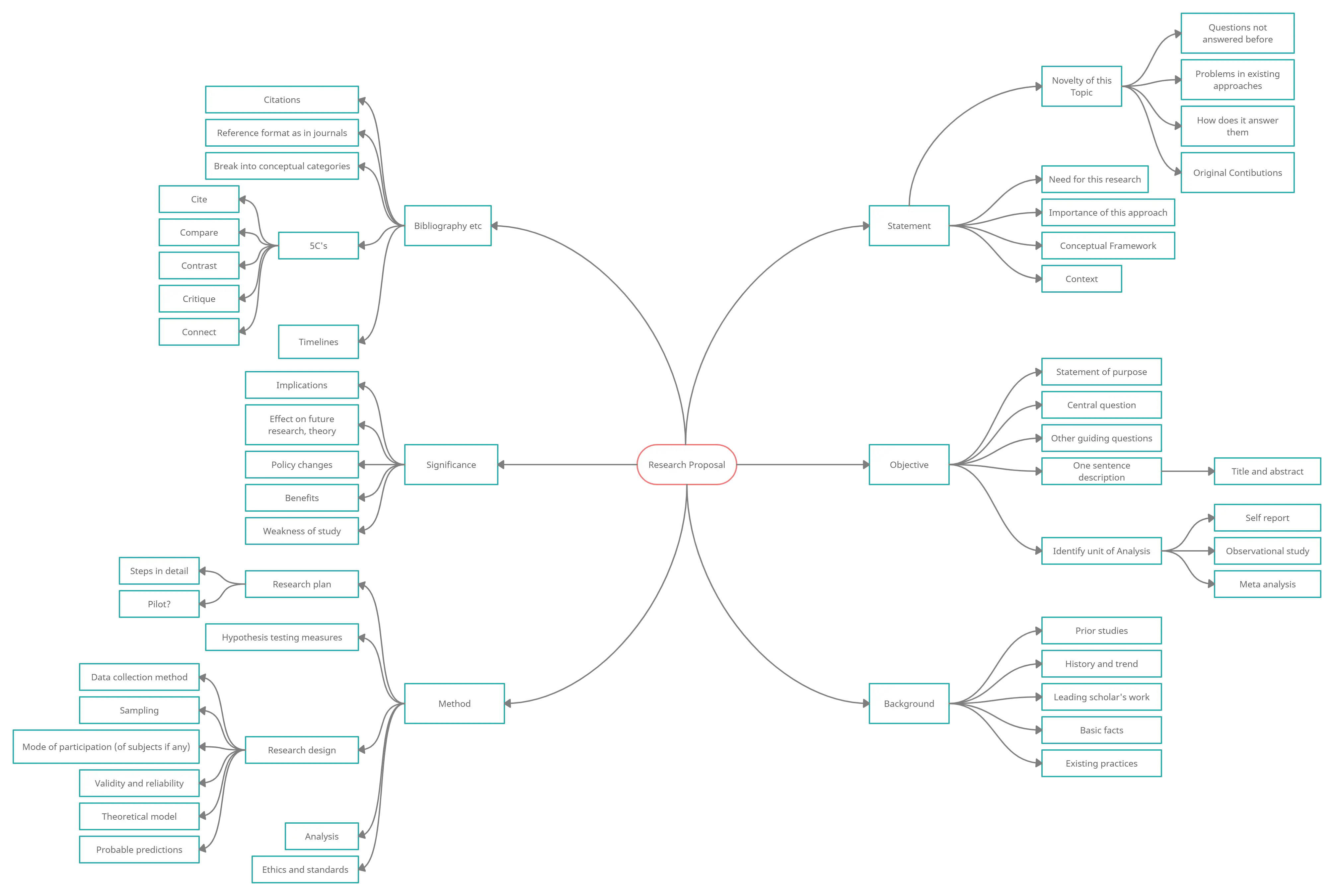A conceptual framework in research is not just a tool but a vital roadmap that guides the entire research process. It integrates various theories, assumptions, and beliefs to provide a structured approach to research. By defining a conceptual framework, researchers can focus their inquiries and clarify their hypotheses, leading to more effective and meaningful research outcomes.
What is a Conceptual Framework?
A conceptual framework is essentially an analytical tool that combines concepts and sets them within an appropriate theoretical structure. It serves as a lens through which researchers view the complexities of the real world. The importance of a conceptual framework lies in its ability to serve as a guide, helping researchers to not only visualize but also systematically approach their study.
Key Components and to be Analyzed During Research
- Theories: These are the underlying principles that guide the hypotheses and assumptions of the research.
- Assumptions: These are the accepted truths that are not tested within the scope of the research but are essential for framing the study.
- Beliefs: These often reflect the subjective viewpoints that may influence the interpretation of data.
Together, these components help to define the conceptual framework that directs the research towards its ultimate goal. This structured approach not only improves clarity but also enhances the validity and reliability of the research outcomes. By using a conceptual framework, researchers can avoid common pitfalls and focus on essential variables and relationships.
For practical examples and to see how different frameworks can be applied in various research scenarios, you can Explore Conceptual Framework Examples.
Different Types of Conceptual Frameworks Used in Research
Understanding the various types of conceptual frameworks is crucial for researchers aiming to align their studies with the most effective structure. Conceptual frameworks in research vary primarily between theoretical and operational frameworks, each serving distinct purposes and suiting different research methodologies.
Theoretical vs Operational Frameworks
Theoretical frameworks are built upon existing theories and literature, providing a broad and abstract understanding of the research topic. They help in forming the basis of the study by linking the research to already established scholarly works. On the other hand, operational frameworks are more practical, focusing on how the study’s theories will be tested through specific procedures and variables.
- Theoretical frameworks are ideal for exploratory studies and can help in understanding complex phenomena.
- Operational frameworks suit studies requiring precise measurement and data analysis.
Choosing the Right Framework
Selecting the appropriate conceptual framework is pivotal for the success of a research project. It involves matching the research questions with the framework that best addresses the methodological needs of the study. For instance, a theoretical framework might be chosen for studies that aim to generate new theories, while an operational framework would be better suited for testing specific hypotheses.
Benefits of choosing the right framework include enhanced clarity, better alignment with research goals, and improved validity of research outcomes. Tools like Table Chart Maker can be instrumental in visually comparing the strengths and weaknesses of different frameworks, aiding in this crucial decision-making process.
Real-World Examples of Conceptual Frameworks in Research
Understanding the practical application of conceptual frameworks in research can significantly enhance the clarity and effectiveness of your studies. Here, we explore several real-world case studies that demonstrate the pivotal role of conceptual frameworks in achieving robust research conclusions.
- Healthcare Research: In a study examining the impact of lifestyle choices on chronic diseases, researchers used a conceptual framework to link dietary habits, exercise, and genetic predispositions. This framework helped in identifying key variables and their interrelations, leading to more targeted interventions.
- Educational Development: Educational theorists often employ conceptual frameworks to explore the dynamics between teaching methods and student learning outcomes. One notable study mapped out the influences of digital tools on learning engagement, providing insights that shaped educational policies.
- Environmental Policy: Conceptual frameworks have been crucial in environmental research, particularly in studies on climate change adaptation. By framing the relationships between human activity, ecological changes, and policy responses, researchers have been able to propose more effective sustainability strategies.
Adapting conceptual frameworks based on evolving research data is also critical. As new information becomes available, it’s essential to revisit and adjust the framework to maintain its relevance and accuracy, ensuring that the research remains aligned with real-world conditions.
For those looking to visualize and better comprehend their research frameworks, Graphic Organizers for Conceptual Frameworks can be an invaluable tool. These organizers help in structuring and presenting research findings clearly, enhancing both the process and the presentation of your research.
Step-by-Step Guide to Creating Your Own Conceptual Framework
Creating a conceptual framework is a critical step in structuring your research to ensure clarity and focus. This guide will walk you through the process of building a robust framework, from identifying key concepts to refining your approach as your research evolves.
Building Blocks of a Conceptual Framework
- Identify and Define Main Concepts and Variables: Start by clearly identifying the main concepts, variables, and their relationships that will form the basis of your research. This could include defining key terms and establishing the scope of your study.
- Develop a Hypothesis or Primary Research Question: Formulate a central hypothesis or question that guides the direction of your research. This will serve as the foundation upon which your conceptual framework is built.
- Link Theories and Concepts Logically: Connect your identified concepts and variables with existing theories to create a coherent structure. This logical linking helps in forming a strong theoretical base for your research.
Visualizing and Refining Your Framework
Using visual tools can significantly enhance the clarity and effectiveness of your conceptual framework. Decision Tree Templates for Conceptual Frameworks can be particularly useful in mapping out the relationships between variables and hypotheses.
Map Your Framework: Utilize tools like Creately’s visual canvas to diagram your framework. This visual representation helps in identifying gaps or overlaps in your framework and provides a clear overview of your research structure.
A mind map to organize research data Analyze and Refine: As your research progresses, continuously evaluate and refine your framework. Adjustments may be necessary as new data comes to light or as initial assumptions are challenged.
By following these steps, you can ensure that your conceptual framework is not only well-defined but also adaptable to the changing dynamics of your research.
Practical Tips for Utilizing Conceptual Frameworks in Research
Effectively utilizing a conceptual framework in research not only streamlines the process but also enhances the clarity and coherence of your findings. Here are some practical tips to maximize the use of conceptual frameworks in your research endeavors.
- Setting Clear Research Goals: Begin by defining precise objectives that are aligned with your research questions. This clarity will guide your entire research process, ensuring that every step you take is purposeful and directly contributes to your overall study aims. \
- Maintaining Focus and Coherence: Throughout the research, consistently refer back to your conceptual framework to maintain focus. This will help in keeping your research aligned with the initial goals and prevent deviations that could dilute the effectiveness of your findings.
- Data Analysis and Interpretation: Use your conceptual framework as a lens through which to view and interpret data. This approach ensures that the data analysis is not only systematic but also meaningful in the context of your research objectives. For more insights, explore Research Data Analysis Methods.
- Presenting Research Findings: When it comes time to present your findings, structure your presentation around the conceptual framework. This will help your audience understand the logical flow of your research and how each part contributes to the whole.
- Avoiding Common Pitfalls: Be vigilant about common errors such as overcomplicating the framework or misaligning the research methods with the framework’s structure. Keeping it simple and aligned ensures that the framework effectively supports your research.
By adhering to these tips and utilizing tools like 7 Essential Visual Tools for Social Work Assessment, researchers can ensure that their conceptual frameworks are not only robust but also practically applicable in their studies.
How Creately Enhances the Creation and Use of Conceptual Frameworks
Creating a robust conceptual framework is pivotal for effective research, and Creately’s suite of visual tools offers unparalleled support in this endeavor. By leveraging Creately’s features, researchers can visualize, organize, and analyze their research frameworks more efficiently.
- Visual Mapping of Research Plans: Creately’s infinite visual canvas allows researchers to map out their entire research plan visually. This helps in understanding the complex relationships between different research variables and theories, enhancing the clarity and effectiveness of the research process.
- Brainstorming with Mind Maps: Using Mind Mapping Software, researchers can generate and organize ideas dynamically. Creately’s intelligent formatting helps in brainstorming sessions, making it easier to explore multiple topics or delve deeply into specific concepts.
- Centralized Data Management: Creately enables the importation of data from multiple sources, which can be integrated into the visual research framework. This centralization aids in maintaining a cohesive and comprehensive overview of all research elements, ensuring that no critical information is overlooked.
- Communication and Collaboration: The platform supports real-time collaboration, allowing teams to work together seamlessly, regardless of their physical location. This feature is crucial for research teams spread across different geographies, facilitating effective communication and iterative feedback throughout the research process.
Moreover, the ability t Explore Conceptual Framework Examples directly within Creately inspires researchers by providing practical templates and examples that can be customized to suit specific research needs. This not only saves time but also enhances the quality of the conceptual framework developed.
In conclusion, Creately’s tools for creating and managing conceptual frameworks are indispensable for researchers aiming to achieve clear, structured, and impactful research outcomes.







